Delicious Chicken Katsu Onigirazu made with healthy baked chicken katsu, tonkatsu sauce, mustard, steamed rice, and thinly sliced cabbage.

Onigirazu for school lunch has been mutual love between my children and myself. As a mom, I love that I can easily stuff leftovers inside the square shape onigiri sandwich. For the children, they said they love that all the ingredients (rice, main dish, vegetables) are in one rice ball/sandwich which is portable and fits in their small hands.
I asked them to give me their top 5 onigirazu that I make, and they answered. This Chicken Katsu Onigirazu (チキンカツおにぎらず) is their #1 top favorite onigirazu.
Since they love tonkatsu and chicken katsu, I’m not too surprised that this is their favorite. From their answers, I realized that my kids prefer simple filling rather than my “creative” onigirazu.
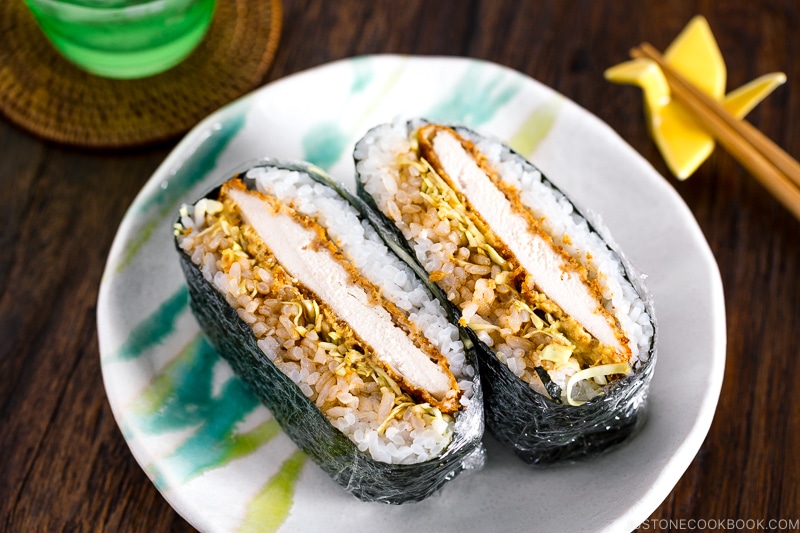
What is Onigirazu?
Onigirazu is a rice ball (onigiri or omusubi in Japanese) that is NOT squeezed tightly into the traditional shape, like round or triangle.
You can put more fillings inside, as the “rice ball” shape is square and you can spread the ingredients just like how you lay them out for a sandwich. You wrap the fillings from the four corners of nori. So it is kind of like “wrapped rice ball”.
If you want to learn more about, you can read this post.

How To Make Baked Chicken Katsu
For Chicken Katsu Onigirazu, I almost always use my Baked Chicken Katsu, a popular recipe on Just One Cookbook.
If you’re new, you can check out how I make my chicken katsu “baked”, by pre-toasting panko with just one tablespoon of olive oil.

Other Onigirazu Recipes
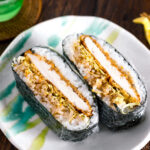
Chicken Katsu Onigirazu
Ingredients
- 1 baked chicken katsu
- 1–2 leaves green cabbage
- 1 sheet nori (dried laver seaweed)
- 1 cup cooked Japanese short-grain rice
- ⅛ tsp Diamond Crystal kosher salt
- 1 tsp Dijon mustard
- 1–2 Tbsp tonkatsu sauce
Instructions
- Gather all the ingredients.

- Cut 1–2 leaves green cabbage into julienned slices.

- Place a plastic wrap on a working surface and put 1 sheet nori (dried laver seaweed) on top (shiny side facing down), with a corner pointing up.
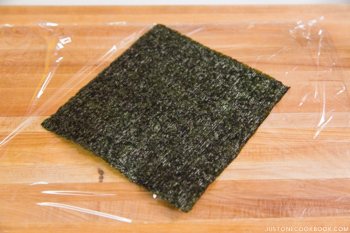
- Evenly spread about ½ cup cooked Japanese short-grain rice in a thin layer and form into a square shape in the center of nori sheet. Sprinkle ⅛ tsp Diamond Crystal kosher salt. For Japanese rice ball (onigiri) that are enjoyed at room temperature, we add salt to the rice to keep the food fresh longer.

- Place the shredded cabbage evenly on top of rice and then 1 baked chicken katsu on top.

- Spread 1 tsp Dijon mustard and 1–2 Tbsp tonkatsu sauce.

- Flip over chicken katsu so the sauce is also on the cabbage.
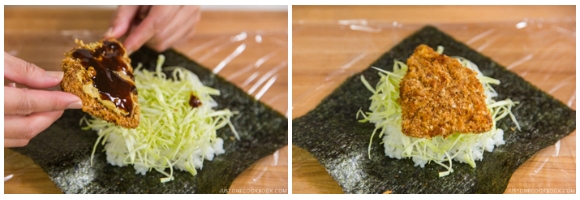
- Place another ½ cup steamed rice on top. Try to keep the square shape as you spread the rice evenly in a thin layer. Bring left and right corners of nori sheet towards the center. Fold gently but tightly to wrap around the layers at the center.
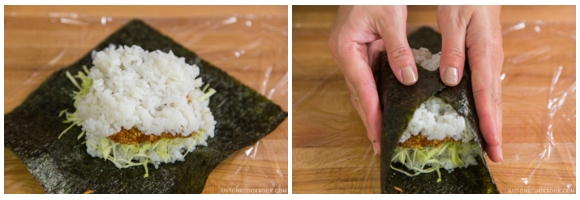
- Then bring the bottom and top corners towards the center. Continue to fold gently but tightly around the layers. Make sure the rice is tucked in nicely.

- If you like the onigirazu to showcase the filling after cutting in half, mark with a piece of shredded cabbage perpendicular to the filling. Wrap with plastic wrap tightly and set aside for 5 minutes.

- Cut the onigirazu with a sharp knife (following the direction of the “cabbage” mark). Run your knife in cold water before cutting so that the cross-section will be clean.

To Store
- If you plan to make it ahead of time, wrap the onigirazu with a thick kitchen towel and keep it in the refrigerator overnight. The towel will prevent the rice from getting hard and dry from cold air (but it‘s impossible to keep it moist/fluffy). I strongly recommend making onigirazu on the same day you enjoy it.



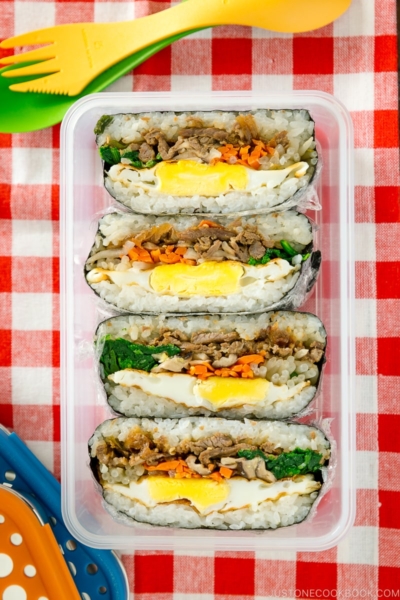




Is there a way to make this without seaweed? Maybe with rice paper or something? This looks SO delicious, but I hate the taste of seaweed! Dx It always makes me gag.
Hi Jessi! If you have an Onigirazu mold, you “could” shape into square/rectangular without the seaweed easily. Or you can just omit nori and try to shape well with plastic wrap. 🙂
Thanks for sharing! Do you eat it cold or hot? If hot, how do you heat it up? Thanks!
Hi Jenny! Japanese bento is served and eaten at room temperature. If you are at work, maybe your office might have a microwave, but in Japan we grew up eating room temp bento so we don’t always feel the need to heat up. We pack food that tastes good at room temp (and season a little stronger for that reason). And onigirazu is eaten at room temperature as well, not hot. 🙂
Hi Nami!
Thanks a lot for your wonderful recipes, I already tried a few and everything turned out delicious, including chicken katsu onigirazu. I have a couple of questions though… I’m planning to make it again for my family and my mom is a vegeterian so I was thinking if I could use deep fried tofu instead?.. What do you think? And also, what other vegetable aside from cabbage might blend in nicely with the rest of the flavors? I’d be very thankful if you could give some tips. Thank you! And Happy New Year btw! 🙂
Hi Muslima! Happy New Year! I’m so happy to hear you’ve tried my recipes and enjoyed them. 🙂 Hmm deep fried tofu with rice… It’s a bit strange combination to me… I think the vegetables or stir fried vegetables would go better with rice/rice ball/onigiri in general. But I’ve never tried it with tofu, so it might work. It’s hard to tell unless you give it a go. 🙂
Is the steamed rice just typical long grain rice, or is it sushi rice (with or without seasoning). Thankyou, looks wonderful, cant wait to try!
Hi Blake! We don’t use long grain rice for Japanese food. Always short grain rice. 🙂 The texture is more sticky (but remember this type is different from what’s called “sticky rice”) and more plump and sweeter.
And Japanese only say “sushi rice” when it’s seasoned with sushi vinegar for making sushi. Other than that, we just say rice. So this recipe requires just plain steamed rice.
Hope you enjoy! 🙂
Can one makes this the evening before and eat it the next day or will it get mushy from moisture? Alot of these type dishes are made for lunch right? Do you make it in the morning? Or can it be prepared the evening before?
Hi Charlie! Most Japanese moms wake up at 5 to 6 am to make kids’ and husband’s lunch. Majority of moms/wives. However, I know most of us (outside of Japan) don’t do that… so I still encourage people to make it previous night, keep it in the fridge, keep it cool with ice pack for food safety till lunch time. If you don’t want it cold, maybe take it out 1 hour before lunch time.
Now, if it’s regular onigiri or rice ball. You have an option of keeping rice ball and nori (seaweed) separate, especially if you prefer nori to be crispy. You can open the package and wrap the rice ball when you eat.
However, when it comes to Onigirazu, whether you eat right away or hours later, you will rely on nori to be wilted so that you can wrap around the rice nicely – like a gift wrapping.
So, nori will be always wilted. We use hot/warm rice for onigirazu so that nori will become soft and easy to wrap.
The nori will not be crispy because of that, but if you make onigiri or onigirazu “right”, I wouldn’t call the texture “mushy”. A lot of sushi rolls I’ve seen in America are super mushy because the rice is smashed and there is not single grain that is visible (sort of). When you tightly squeeze rice ball or make onigirazu, never mash the rice. Then it won’t be “mushy”. 🙂 Hope this helps!
This recipe looks amazing! 🙂 Really want to try it out!
If I make the onigirazu the night before and leave it in the fridge, does that mean I need to keep it cold until I actually eat it or I can leave it out till room temperature?
Hi Jessica! Thank you! If you’re planning to eat lunch, I still recommend to keep the onigirazu in an insulated bag with ice pack for safety, especially in the summer time. You can take it out for an hour (if you can) to bring it to room temperature. Another thing is that if you keep in the fridge, make sure to wrap the onigirazu with kitchen towel or something os that rice doesn’t get too cold and become hard. 🙂 Hope you enjoy!
Hi Nami 🙂
I found your site yesterday and really like it a lot. I love how you describe the backgrounds and words for the dishes and your instructional pictures.
I am very interested to try onigirazu, but have one question. I am unsure of this: Is the steamed rice hot or room temperature when you make the onigirazu?
Hi Anne-Mette! Welcome to my blog! So happy to hear you like my blog already and thanks for reading!
I just updated the recipe and added ”warm” steamed rice. It helps the nori to get wilted so you can wrap easily and tightly. 🙂
Hope you enjoy!
Thank you, Nami 🙂 Yesterday I ordered a lot of ingredients to make this onigirazu and today I ordered a small rice cooker. As we don’t know if we will like nori at all, I have also ordered some rice paper/spring roll wrappers to use in case nori is just not for us. I plan on making you recipe sometime in the coming week and am looking very much forward to it 🙂
Hi Anne-Matte! Sounds great! Hope you enjoy! Just for FYI, good quality nori makes a huge difference in taste and texture. I feel like nori that we can get outside of Japan is not very tasty and give people wrong impression. 🙁 Nori you can find in Japan is so delicious… hard to compare. 🙂
I tried this the other day & everyone (in the family) love it!
The only thing I want to improve on is the texture of the seaweed. I don’t mind it being softened because of the warm ingredients. But how can I prevent it from being chewy? I purchased the seaweed from a reputable Japanese wholesaler (who also do some retails products), so I am hoping that it’s the quality of the seaweed.
Hi Elvina! I’m so happy to hear your family enjoyed this recipe! Either I don’t consider my nori to be “chewy” or I have different quality nori that is not chewy… Is it really chewy like it’s hard to bite off – kinda chewy? Sorry I try to understand as I can bite off without any problem (or I might have sharp teeth haha). It’s a little elastic once it’s wilted, but… I wouldn’t say chewy. I just asked Mr. JOC and he said he wouldn’t call it chewy texture. Sorry I really wish I could help…
Hi Nami, do you recommend using oven-baked katsu over the fried version for this specific onigirazu recipe? Is it because it tastes better since eaten cold or is there no difference really? I make your deep-fried katsu recipe once a week now and its’s my 5 year old daughter’s favorite dish “in the whole world” as she’d say. But I’m super keen to try the baked version too. Thank so much for sharing the onigirazu recipe, it will be a great addition to my daughter’s lunch bento boxes.
Hi Alex! To me, it doesn’t matter if it’s fried or deep fried for Onigrazu recipe. It’s more of personal preference. For taste wise, I have to say deep fried version is better, but considering the amount of work, health, messy/smelly kitchen, and all that, baked version is not bad at all and the benefit might win over that deep fried flavor….
Whether it’s cold or not, the deep fried version has the “deep fried” oil taste that is delicious. Baked version is cleaner without that oily taste.
I’d recommend trying baked version once and see if your daugther likes it. It’s not too good to feed too many deep fried foods to kids (or us), so it might be nice to swtich to baked version once in a while for health wise. 🙂
Hope this helps!
Thanks so much Nami!! I so appreciate your feedback and I agree with you. I look fwd to trying the baked version. Fabulous, thanks again!
Hello Nami. I just returned from Japan (2 days ago! Already craving more!) and just found your website while searching for Japanese food recipes. I thoroughly enjoyed my visit to Tokyo, Kyoto, Osaka, Hiroshima, Kanazawa and Nikko. I love Japan and I definitely will be cooking, inspired by your recipes. I cannot wait to make this (chicken Katsu curry was one of my favourite meal there).
Hi Carole! I hope you had a wonderful trip to Japan! I’m so happy that you found my blog! Welcome! 🙂 Hope you enjoyed chicken katsu (either my baked version or deep fried version) with curry! It’s so delicious! 🙂
Hi nami…
Thx for all your tasty recipe.
Can i make it without nori sheet? Will the rice stay tight without it? Because my kid doesn’ t nori sheet since it a little bit chewy.
Many thanks
Jeny
Hi Jeny! Thank you for trying my recipe! You can make it without nori sheet, but would you make it with plastic wrap around it? It can be a little more challenging but I think it’s possible. I also recommend getting good quality nori sheet which shouldn’t be so chewy (I think). 🙂
I’m never sure what kind of nori to use, and sometimes end up using “chewy” nori that doesn’t easily break apart when biting into musubi. Is there a particular brand or type you can suggest?
Hi Kathy! I usually buy nori that I can find from a Japanese market. I look for 2 types in general – organic and more expensive ones… I can’t afford one bag with 5 sheets that costs $10 (or something like that) but I usually buy “premium” or “best” or a product that has higher price. More money doesn’t mean good for everything, but it’s pretty good indicator. We really have limited types of nori we can get in the U.S., and even the expensive ones taste just okay… not the best. So I try to get ones that has better quality…
We are trying this tonight! My favorite onigirazu is spam and fried egg! Thanks for all the yummy recipes!
Hi Lily! Agree, the salty spam and egg is a match in heaven! 🙂
Wow! This looks easy to make and delicious. And I can definitely find these ingredients in my country. Thank you once again, Nami!
Hi Jerry! I’m happy to hear that! Thank you for reading this post! 🙂
I love the idea of baked tonkatsu!! I was wondering if you can make these onigirazu ahead of time and if so how long can it last in the fridge?
Thanks.
Hi Joyce! Baked tonkatsu or chicken katsu is awesome! It’s pretty close to the deep fried version, and if you don’t like deep frying or trying to avoid deep fried foods, this is a great alternative!
Yes, you can make it ahead of time (like previous night with the leftover food). To keep in the fridge (I always recommend to keep in the fridge overnight), wrap around the towel so that rice doesn’t get too hard from cold air. 🙂